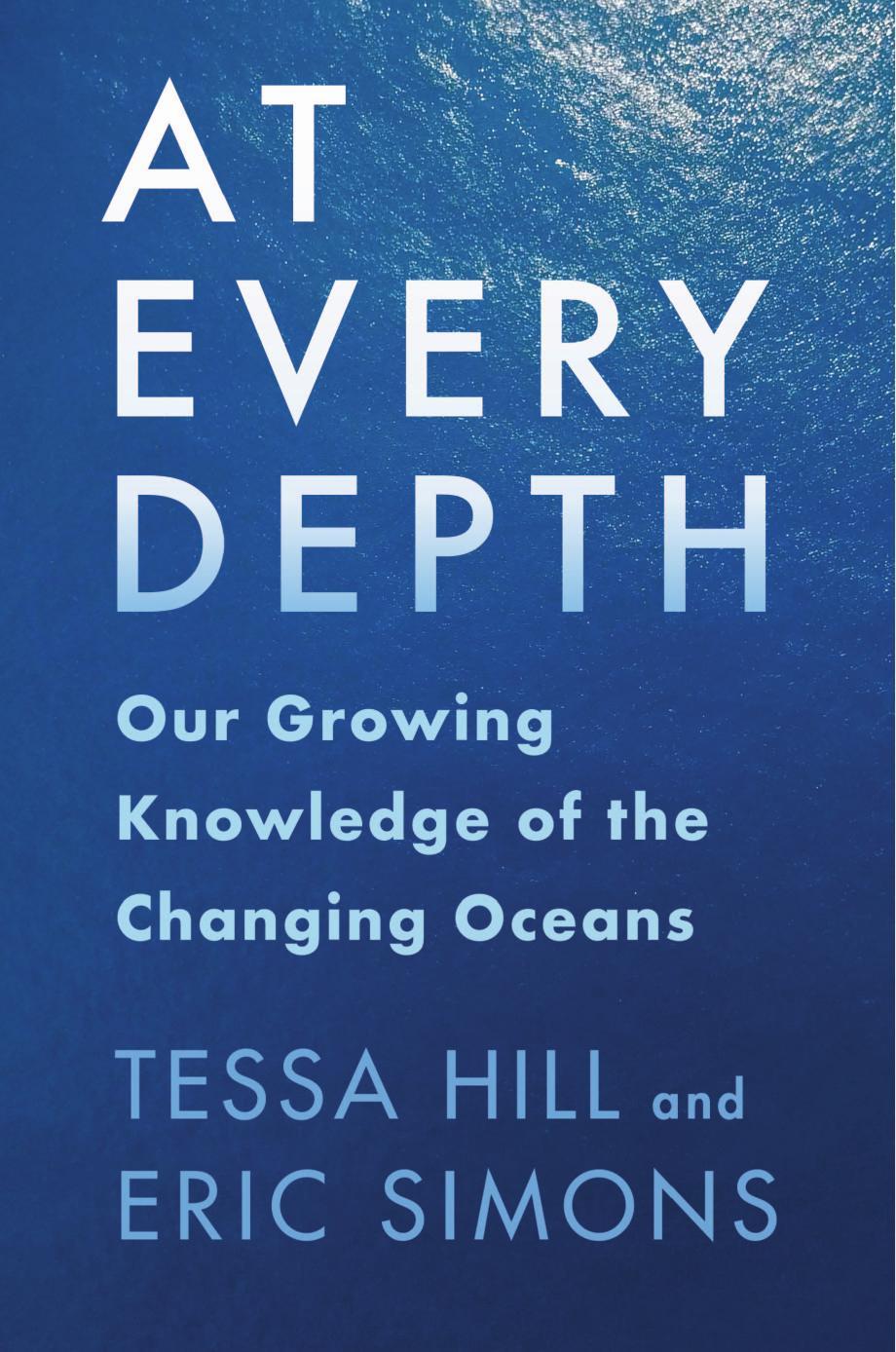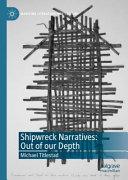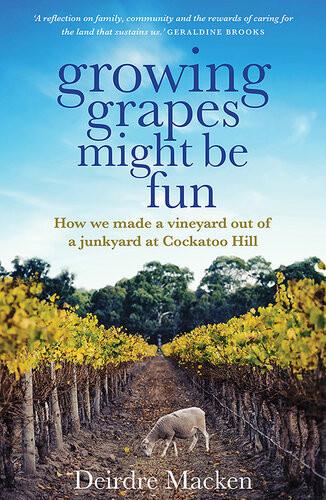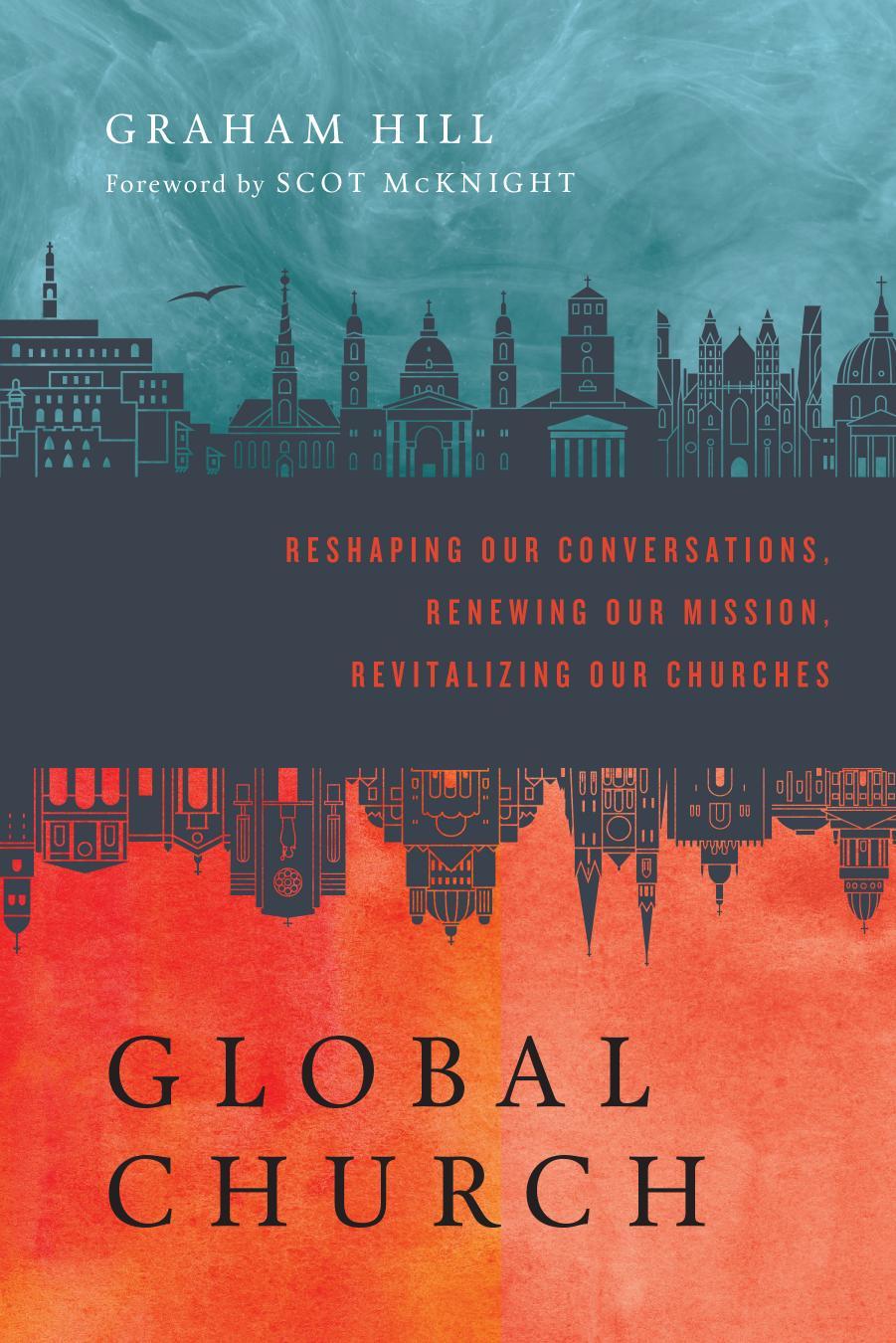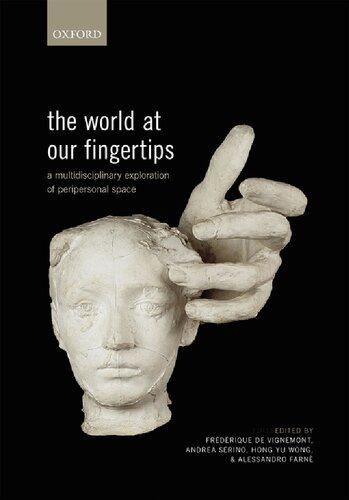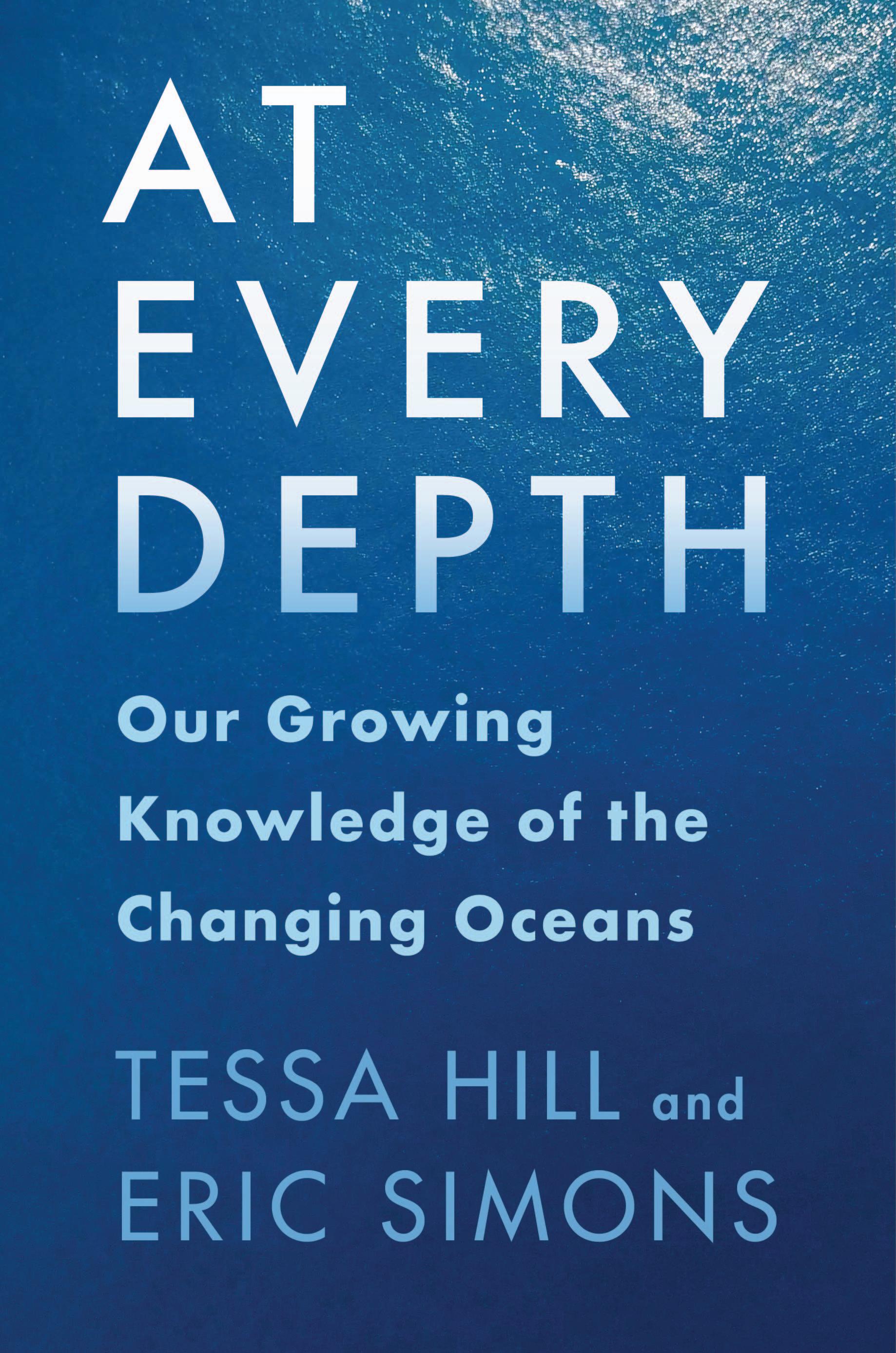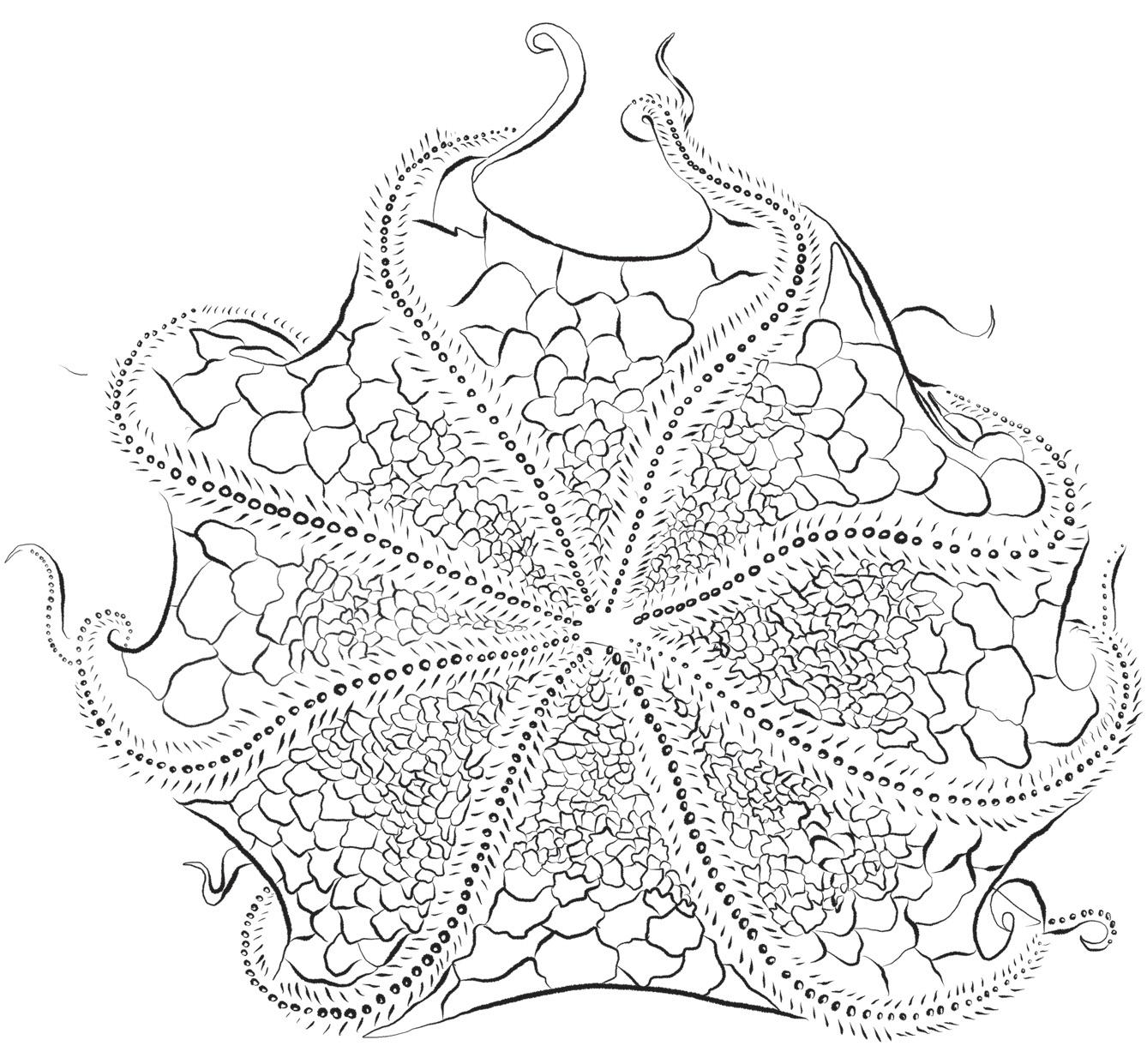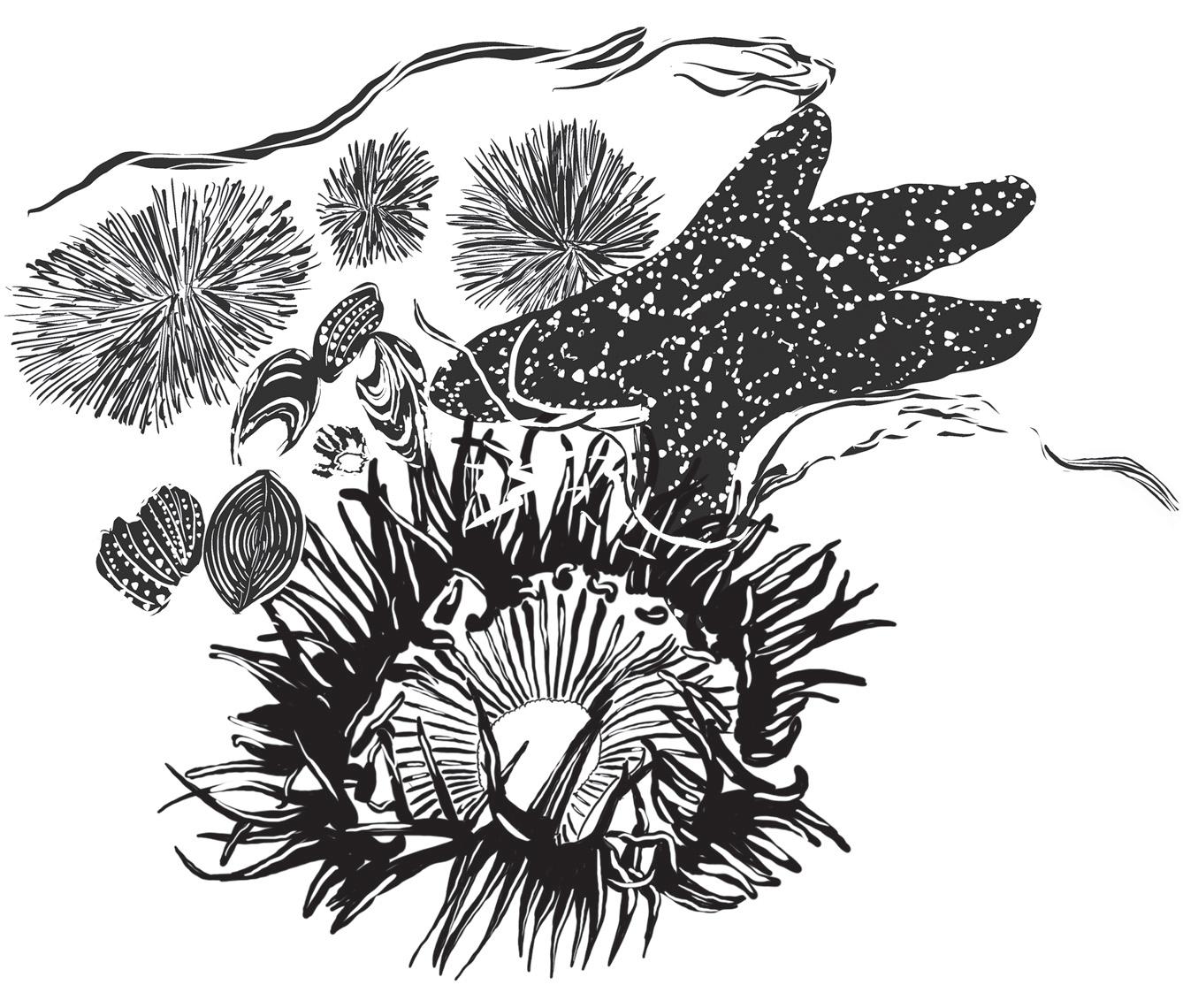THE TIDE POOL
Who has known the ocean? Neither you nor I, with our earth-bound senses, know the foam and surge of the tide that beats over the crab hiding under the seaweed of his tide-pool home; or the lilt of the long, slow swells of mid-ocean, where shoals of wandering fish prey and are preyed upon, and the dolphin breaks the waves to breathe the upper atmosphere.
—Rachel Carson, Undersea
We often hear how little people know about the ocean. The challenge with the ocean, of course, is that it is hard to wrap your arms around it: the expanse, the depth, the eternal blueness. Yet we should also not pretend that we don’t know anything at all. What we know is, in fact, remarkable. The human exploration of the ocean over millennia, in every place where we could touch, observe, listen, poke, and prod, has led us to a considerable understanding of its nature. Now we face a new difficulty, one greater than even the physical or scale limitations we’ve come up against so many times before: the ocean is changing so fast. How do you understand change affecting two-thirds of the surface of our planet? How can we tell a story about the ocean and people and our collective future while simply sitting on the shore?
You can start, as our story will show, with a tide pool. The tide pool is an entire universe, rocks and sun and water, forests and shrubs and meadows, grazers and roamers and apex predators, all fully contained in a few feet of rock and reset with each change in tide. It captures, too, the ocean’s extremes. It warms in the sun then chills rapidly once the ocean water returns. As animals breathe out carbon dioxide in an isolated pool, the chemistry changes dramatically, a preview
of a changing future ocean worldwide. In a storm, a tide pool can be diluted by fresh water, and at high tide it flushes with salt. It seems an impossible place to live and yet it is, as John Steinbeck once wrote, “ferocious with life.”1
Rocky tide pools make up a very small percentage of the Earth’s surface. But they have been home to pioneering experiments in our understanding of the natural world and have shaped the minds of some of the brightest scientists, writers, and artists in history. Nearly one-quarter of the Greek philosopher Aristotle’s surviving writing concerns his interest in marine biology, developed over decades spent peering into Mediterranean tide pools and consulting local fishers. The last two books that the English naturalist Charles Darwin published before announcing the idea of evolution in On the Origin of Species were deeply researched monographs about barnacles. Rachel Carson, who is often credited with kickstarting the American environmental movement with her 1962 book Silent Spring, spent the first decade of her professional life as a marine biologist for the U.S. Fish and Wildlife Service, observing tide pools as well as salt marshes and sandy beaches; the last book she wrote before Silent Spring was called The Edge of the Sea. The former National Oceanographic and Atmospheric Administration (NOAA) administrator Jane Lubchenco, appointed to the White House Office of Science and Technology Policy under President Joe Biden, launched her scientific career studying seaweed distribution and food web interactions in tide pools.2
Ideas about competition, cooperation, predation, and even animal behavior have originated in the tide pool, where scientists can watch a complete universe at work. If you’ve ever heard a wolf, lion, or shark called a “keystone species,” you’re appreciating a concept that scientists first gleaned and refined by watching sea stars hunt in the rocky mussel beds of coastal Washington.3 Like peering at the stars in outer space to understand the rules of gravity, we can peer into a tide pool to map the invisible ecological forces that shape our entire world.
“Ecologists are often accused of having physics envy,” Karina Nielsen, a marine ecologist and the director of Oregon Sea Grant, told us. “Because physicists model things and come out with simple models that have strong explanatory power. But that doesn’t mean there aren’t underlying principles that drive the [ecological] patterns that we see, and that they can’t be understood.”
As a species, we humans also have a longer relationship with the shoreline edge than with any other kind of ocean habitat. Scientists use tide pools as a model for ecosystems, but they serve just as well as an analogue for our connection to
nature. The human ability to read nearshore change goes as far back, some scientists think, as the modern human mind.4 Early in our history, as people were first starting to spread across Africa, the climate changed, and vast deserts formed in the interior.5 Some early humans decamped to the rocky shoreline. At one cave site at Pinnacle Point in South Africa, paleoanthropologists have found shells, food, and tools dating to 164,000 years ago.6 Based on calculations of past sea levels, the caves would have been a few miles inland at the time. To survive there and then, our species would have had to know or learn about tides and how to make a priority of a trip to the ocean. “I surmise that the people who lived at [Pinnacle Point] . . . scheduled their trips to the shore using a lunar calendar of sorts, just as modern coastal people have done for ages,” the archaeologist Curtis Marean wrote in Scientific American in 2010. Although the field of human origins has many competing theories, Marean says that he believes the evidence from those caves showed that in a time of climate change and mortal peril for our species, the tide pools—the ocean—“saved humanity.”7
Now, as the ocean changes more rapidly than it has in human history, the understanding of the tide pool we have built over millennia will matter. To measure change, you have to have a baseline to measure it against. Tide pools, one of the oceanic habitats we know best, may be one of the most valuable baselines that we have to understand the past and present global ocean.8
One of the world’s most studied shorelines stretches 3,000 miles down the western edge of North America, from Alaska to Baja California. Winds swirling in the Gulf of Alaska cascade down the coast, stirring up the ocean and upwelling cold, nutrient-rich water that sloshes against the rocky edge of the continent. In many places along the rocky shoreline of the West Coast, there might be hundreds of visible species and thousands of individual animals in a few square yards. To take one particularly meaningful example: in the mid-1990s a small team of ecologists surveyed a narrow, 108-yard-long, one-yard-wide stretch in a tide pool area in central California. After two years of visits, they had counted 125,590 individual animals on the rocks, representing 135 different species. Even that was a limited total. The scientists admit they chose to ignore one species of clam, three abundant species of small snail, and all the various colony-forming tunicates and sponges, which were simply too difficult to count.9
This closely investigated tide pool in Pacific Grove, California, formed where a crown of granite pushes out northeast into Monterey Bay. The rock slabs lean at angles against one another like a giant tumbled set of children’s blocks. In the deep fissures, cracks, and channels between the rocks, the blue water sloshes through. The incredible biodiversity in the tide pools feeds a host of larger animals that move through. Otters splash into the shallows; egrets and herons stand still in the water; gulls and oystercatchers perch on the mounds of seaweed that pile on the lower rocks. On the smooth, rounded tops of the higher rocks, cormorants spread their wings like decorative gargoyles overlooking a castle. The cormorants preside over a piece of shoreline with a variety of names today. Where the rock pushes out farthest into the bay, it forms Point Cabrillo, named for the European navigator who visited the California coast in 1542. The rocks and pools sit just inside the southern boundary of the Lovers Point–Julia Platt State Marine Reserve and just north of the Edward Ricketts State Marine Conservation Area. Directly above them, in a series of low, barracks-style buildings is Stanford University’s Hopkins Marine Station.
People lived around and visited these tide pools for millennia before the arrival of Europeans. Today the Indigenous people of Monterey Bay go by a variety of names, including Rumsen, Rumsien, Ohlone, Costanoan, and Esselen. All but the Esselen once spoke Rumsen, a language based in a family shared with people to the north in the San Francisco Bay Area. Historians and linguists call these the Ohlone languages, and—although the people at the time likely would not have seen themselves as organized by their primary language—tend to separate groups today by the primary Ohlone dialect they spoke.10 The Spanish called them all costeños, coast people.
On New Year’s Day, 1603, it snowed in Monterey. The nearby Santa Lucia Mountains turned white. It reminded the Spanish navigator Sebastián Vizcaíno, who had anchored just off Point Cabrillo, of the Popocatepetl volcano in central Mexico, where his voyage had started.11 Water left out overnight froze on the Spanish ships, and a crust of ice several inches thick formed on freshwater ponds. A small group of Spanish set off to explore the land around Monterey, hiking through the bitter cold as far as Carmel. They reported empty villages; everyone had moved inland to wait out the weather. Two days later, the Spanish were gone, sailing
north up the California coast for Cape Mendocino, skirting the entrance to the San Francisco Bay that they did not yet know existed. It would be more than 150 years before they returned, this time to stay. In 1769, Spanish soldiers marched north from San Diego to look for the Monterey harbor Vizcaíno described. They had been sent to look for a place to establish an outpost against the English and the Russians, and Monterey seemed promising. By 1772, the Spanish had built a base in Monterey and a mission in nearby Carmel. The Spanish compelled the Indigenous people they found to relocate into the missions, centralizing people who had once spread out across the land according to the seasons. Spanish settlers banned the practice of burning oak woodlands, which had encouraged tree and grassland growth, and carved the land into ranches, introducing cattle herds and invasive pasture grasses.12 In the summer and fall today, two centuries later, the hills of the Golden State turn gold from the sun shining on Spanish oats, fescue, and barley. For coastal Indigenous people, this part of history marked the beginning of a centuries-long resistance to colonial oppression and rule, and fighting to maintain their connection to the land and sea that had been honed over thousands of years. Even beyond the Mission era, “Native people creatively reaffirmed their connections to place and cultivated a sense of belonging within homelands increasingly becoming home to others,” the Coast Miwok and University of California, Santa Cruz, archaeologist Tsim Schneider writes.13
Change in the ocean is not always so evident as change on land. The invasive weeds growing along the roadside are there for anyone to see, but only those with experienced eyes see the algae expanding in a tide pool or once-common shells becoming rare. Change, however, happens whether most people see it or not. Beneath its eternally blue surface, in the pools around its timeless granite, the ocean where Vizcaíno anchored in 1603 must have been shockingly different from the one you would see out the window looking at Monterey Bay today. And because people don’t live in the water, it has been one of the great challenges in culture and in science for the witnesses who do see the ocean changing to convince the world of what they know.
In 1931, a young man named Willis G. Hewatt arrived in Monterey. Hewatt had just received a master’s degree in biology from Texas Christian University in Fort Worth, Texas, and married his wife, Elizabeth. The day after the wedding,
the couple drove west. Hewatt had decided to continue his academic work and pursue a PhD in the tide pools of Pacific Grove, California.14
He arrived in a town booming with cash, culture, and science. Monterey in the 1930s was home to a literary community headlined by John Steinbeck. When he wasn’t writing, Steinbeck explored his love of marine biology in field classes in the tide pool behind the new Stanford University Hopkins Marine Station. The marine station, built on top of a fishing village after the eviction of the Chinese immigrants who had made a home there, had rapidly established itself as one of the nation’s premier marine biological laboratories, a West Coast rival to the famed East Coast labs at Cold Spring Harbor Laboratory, New York, and Woods Hole Oceanographic Institute, Massachusetts. On the Monterey waterfront, fishers, boat operators, and factory workers thrived in the seemingly inexhaustible sardine fishery that gave name to Steinbeck’s 1945 novel, Cannery Row
Just south of Hopkins, near where the Monterey Bay Aquarium was built a half century later, a marine collector named Edward Ricketts operated a mail-order biology supply store called Pacific Biological Laboratories. Ricketts was working on a manuscript for a book called Between Pacific Tides, a first-of-itskind guidebook to the tide pool that focused on life from shallow to deep, as a collector might find it, instead of arranged taxonomically. The manuscript was at first rejected; the director of the marine station at that time wrote that “the method of taking up the animals from the standpoint of station and exposure on the seashore seems at first sight very logical but from the practical standpoint it seems to me not particularly happy.”15
But Hewatt, who read Ricketts’s first draft in the Hopkins library, found the idea of a tide pool organized by zones intriguing. Hewatt decided he wanted to study the arrangement of animals in a tide pool for his dissertation. In 1931, he drove a series of four iron bolts into the Pacific Grove granite. For the next three years, he went out at low tide and counted and categorized all the tide pool inhabitants in one square yard around his bolts. The study site, stretching from a nearshore boulder below the marine station to a large mussel bed 324 feet out into the tide pools, became known as Hewatt’s transect. Yet its creator couldn’t imagine the significance his site would one day hold. Upon the conclusion of his work in 1935, he filed his dissertation with his committee, received approval of his work, and moved back home to Texas to become a professor of biology at Texas Christian University. Mats of purple and brown seaweed soon grew thick over the transect bolts. People knew Hewatt had been there but couldn’t say
exactly where. His dissertation was published in the American Midland Naturalist in 1937, and perhaps only few noticed.16 After all, how could it matter?
On a clear winter day in 2019, the ecologist Jim Barry walked us from the Hopkins Marine Station along a dusty path to the edge of the bluff, past a pair of sea otter researchers standing over a spotting scope, and toward the tide pools. It’s a scramble down a head-high drop from the bluffs to the beach, onto a thick layer of broken mussel shells that crunch near the water’s edge. The rocks here date to around 80 million years ago, little broken-off pieces of volcanic deposits, bumping northwest over the eons in the fault zone between the Pacific and North American geologic plates. Worn and eroded, they nonetheless feel as eternal as the blue ocean around them. When he was a graduate student in San Diego, Barry would try to work in the crumbling and constantly shifting sandstone of the tide pools of La Jolla. “Granite,” he said, appreciatively, noting the contrast. “It’s here forever.”
When Barry started his marine biology career in 1991 as a young scientist at the Monterey Bay Aquarium Research Institute, his office was right up the street from Hopkins, and he’d often come down to the lab to talk to the station’s resident elder, Chuck Baxter, who’d been lecturing to Stanford University undergraduates since the 1970s. Barry was a scientist and a surfer who had been hooked by the ocean early as a kid growing up in Northern California. He had spent summers in the Antarctic as a research assistant and earned a PhD in oceanography from the Scripps Institution of Oceanography in San Diego. Baxter was a thinker and philosopher who knew the history of the place and everyone who’d come through it like he knew his own family. He’d worked up and down the West Coast, read deeply of Pacific history, and been one of the founding scientists at the Monterey Bay Aquarium. Once, Baxter mentioned to Barry that he felt like things had changed in the tide pools out the window. He looked out at the water pouring through the rocks, and he felt something about it looked like Southern California. They got to talking. Baxter had been thinking already about the Hewatt transect, and now he wanted to return to it. According to the predictions of the still-new science of global warming, you would expect marine creatures to move north toward colder water at the pole. Maybe Baxter’s gut feeling that he saw Southern California out the window had a basis, one that Hewatt’s historic descriptions of the tide pool might allow observers to unveil.
Every year, Stanford undergraduates would come down to the marine lab from Palo Alto and spend a quarter there doing research. Baxter saw a resurvey of Hewatt’s transect as an ideal undergraduate project, and for several years running, he unsuccessfully pitched the idea of studying the transect to students. In 1993, Raphael Sagarin and Sarah Gilman took him up on it. Both were juniors, and unlike many of the premed students at the research station, they were interested mainly in ecology. Gilman, now a professor of marine biology at Claremont McKenna in Southern California, says that she had no particular tilt toward the ocean. It was her first marine biology class. She admits the career path she set off on then seems almost accidental now, that if Stanford’s field course had been in the desert, she might these days be a desert ecologist. “But after that quarter,” she says, “I never wanted to study anything else.”
Baxter also recruited his friend Barry to join them. There was only one problem: no one could remember where exactly Hewatt’s transect was. While Hewatt had described the transect carefully in his work, a clear line to sketch out the exact path of his study site was not included in his thesis. So Sagarin, Gilman, Baxter, and Barry plunged into the tide pool to look for Hewatt’s bolts. Barry remembers being out at a low tide in the middle of the night, Coleman lanterns casting the granite in sharp relief, pushing piles of seaweed aside to sweep the exposed rock with metal detectors. Gilman, too, remembers the darkness, the quiet of the 4 a.m. low tide, the feeling of combing the seaweed and later trying to count all the species in her hand. “The number of different animals that you could pull out of a square yard out there—it was . . . magical,” she said. “You have no idea there’s that much diversity down there but if you work your fingers through every tiny bit of algae there’s so much life.”
They found the bolts eventually, and during low tides that year, Gilman and Sagarin would lay down a one-yard-square box at each bolt and count and identify everything within it. By the end of the spring, they had documented 58,000 individual animals. The next step was to compare what they had counted to the species and positioning Hewatt had described sixty years earlier.
In a 1995 article in Science, Barry, Baxter, and the just-graduated Gilman and Sagarin reported that the abundance of eight of nine warm-water southern species had increased at the site while five of eight cold-water northern species had decreased since 1935. The shift coincided with measurements showing that the water at the site had warmed over the decades as a result of climate change.17 Although they had spent their time counting and sorting small marine creatures,
the headline was much bigger. Ocean watchers didn’t have to wait to document change—it was already happening. “I knew it was a big deal because suddenly we’re being interviewed by CNN,” Gilman said. “But in terms of it being cited by people who I look up to and admire as ecologists, it never occurred to me.”
For centuries, many Western scientists and writers had described the ocean as so vast as to be beyond the human ability to disturb. We didn’t need to wrap our arms and minds around the ocean, in some sense, because it was an ever-replenishing spring. Barry, Baxter, Gilman, and Sagarin arrived with evidence at a turning point in the scientific relationship to the ocean. Other scientists had just begun to grapple with the implications of global warming and, because the tide pool resurvey had connected the present to the past, it landed with particular heft. “During that period we really started thinking about how marine systems are changing,” Barry said, “and the future is not one of stasis and stability.”
Nearly three decades later, the human pressure on the ocean has only become more and more apparent. Researchers inspired by the study, who started watching their own research sites more closely after 1995, have now had time to record slow-moving change of their own. Scientists are trained to be observers, to record and document and measure where we’ve come from. In writing, researching, and listening to these stories, we have begun to see their work as an effort to preserve stories—to drive anchors in the granite to provide future generations with a map of a world we once knew.
In the 1830s, Mexico and California became independent from Spain, and the missions were secularized. The Ohlone of Monterey Bay began to make their own way in a world transformed. By the 1840s, Americans began to arrive and claim land of their own or take it by force.
In 1846, an Ohlone woman named Isabel Meadows was born in Carmel. Her mother was a Rumsen speaker who had been born in the mission, her father an English whaler. She grew up in the valley with her mother, grandmother, and great-grandmother, learning a combination of old ways and new. Her life spanned the Gold Rush, American statehood for California, the extirpation of the grizzly bear from the new state, the first calculation of the greenhouse gas effect, and World War I. Hewatt’s first view of the Pacific Grove tide pools nearly coincided with Isabel Meadows’s last look at them. In 1934, when she was in
her eighties, she traveled to Washington, DC, to work with a Smithsonian ethnographer named John Peabody Harrington. Harrington spent the last years of his life trying to interview Native Californian survivors to document vanishing Indigenous languages. Meadows, the last fluent speaker of Rumsen, spent the last five years of hers telling him everything she could remember. In the same years that Hewatt had spent recording one kind of message to the future, Meadows and several other Ohlone elders gifted future generations the information they’d need to revive their culture.
“Isabel’s mind contained information about this specific California Indian community never before recorded, gleaned from her own long life, her mother’s, her grandmother’s, and many significant elders,” writes the Ohlone Costanoan Esselen Nation author and historian Deborah Miranda.18 “Isabel has a clear purpose in depositing these stories with Harrington: to preserve information from Ancestors in ways she knew would provide necessary information for future generations.”
Handwritten in a mix of English, Spanish, and various Ohlone languages, Harrington’s notes went into loosely organized boxes in the Smithsonian and eventually onto microfilm shared with a small number of university libraries. Meadows died in 1939, and Harrington in 1961. By the time a Rumsen woman named Linda Yamane went looking for the Harrington notes in San José in the 1980s, only a handful of people remembered the history or the record of it.
Yamane did not grow up with the songs, stories, language, or environment of her Rumsen Ohlone heritage. She was born in 1949 in San José, a few dozen miles north of Monterey, where her father’s mother’s family had survived the Mission period and American colonization. Her grandmother told her stories from the turn of the nineteenth century, but she didn’t recall much about Rumsen culture.
As she grew older, Yamane’s curiosity about her own history increased. She visited the missions, where the birth and death records of her ancestors had been recorded, but “always came away feeling empty and sad,” she wrote in an essay called “Lost and Found: Ohlone Culture Comes Home.”19 Then, in 1985, someone told her that the San José State University library held a treasure trove of mostly unexamined Ohlone information. It was the microfilm archive of Harrington’s work: vocabulary lists, field notes, and the stories Meadows and a handful of her contemporaries had told the ethnographer.
It was surprisingly difficult for Yamane just to get an appointment to see the microfilm. Librarians gave her conflicting information. When she arrived for the
first time, the person who knew about the microfilm had gone, and the librarian on duty hadn’t heard of it. She told Yamane to come back another day, but Yamane wasn’t ready to accept defeat. “I just couldn’t let go,” she told us. “I was so close and yet somehow they were out of my reach. I was being very stubborn within myself and just couldn’t leave. I began walking up and down the aisles and thinking, ‘They’ve got to be here somewhere.’”
Luckily, the librarian returned and guided Yamane to the microfilm. And through the 1980s and early 1990s, as the Hopkins scientists brushed through seaweed in the darkness, looking for the bolts unvisited since Hewatt left them, Yamane pushed through the darkness of the library stacks in a search for Rumsen knowledge rarely accessed since Meadows dictated it in the 1930s. Later, Yamane wrote about how she felt shy saying her ancestors’ words out loud. She would practice them late at night, sitting awake in bed while her family slept. From basic words she moved to songs, which had been recorded on wax cylinders in Monterey in 1902 and are now archived in the Phoebe Hearst Museum of the University of California, Berkeley. After studying museum collections and talking to basket makers from other Northern California tribes, she became the first Ohlone to weave an Ohlone-style basket in about 150 years. Now a renowned master basket weaver, she has written that one of the most important motivations for making traditional baskets is that “most of our old baskets are gone, but now people can look at one of my baskets, hold it, see the intricacies, and know that our ancestors were resourceful, intelligent, artful people.”20
Interested in the canoes in which the Rumsen navigated their watery world, in the late 1980s she joined a group to build one of the first tule canoes to ply the San Francisco Bay since the 1800s. Since then, she has built more than thirty new tule canoes, including several for a summer program at the Monterey Bay Aquarium. For several years, the canoes were paddled through the Great Tide Pool, an artificial rocky pool fronting Monterey Bay a few hundred feet south of Hopkins Marine Station.21
In the mid-1990s, Yamane also became interested in Ohlone jewelry, which relied heavily on coastal resources. From historic drawings and archaeological materials, she inferred that the Rumsen wore ear ornaments and necklaces using abalone and Olivella shells. She also needed to make hundreds of tiny sequin-like Olivella beads for some of her finest baskets. But this is the challenge when everything has changed, when no one alive knows how to make the thing you want to make. Where do you look? How do you even start? What did your ancestors
know that has been lost? When we asked Yamane what Rumsen speakers like Meadows had said about the ocean, she told us she recalled mainly hints that spoke to a deeper connection. Meadows’s family members would gather salt and seaweed from Carmel, south of Monterey Bay. Meadows’s great-grandmother’s first husband had been an abalone diver and had drowned off Point Lobos. In the post-Mission period, a man would ride his horse up from Pebble Beach with fish for the Meadows family and speak to Isabel’s mother in their language and trade fish for food from the farm.
Yamane started to reforge the connection so she could make jewelry. She went to the beaches and explored. She found two sites for Olivella, one in Monterey, one in Carmel. To her surprise, the shells at each site were quite different. The ones in Monterey were smaller and whiter. The ones in Carmel were larger, sometimes “humongous,” she told us. They tended to be mostly brown or gray, less useful for traditional purposes that prized white shells. Had it always been this way? Did her ancestors know the variation in Olivella shells up and down the coast? Did they have favorite collecting spots where they would find the shells that were just right?
She learned to heat-treat the shells in hot sand. It further whitens them, Yamane told us, but also changes the texture, making the shells more chalky and less brittle. “Olivellas will fracture along their vertical growth lines,” Yamane said. “You lose a lot of material when you’re trying to make beads, because so many of them fracture. It was through a lot of trial and error that I learned, through practice and reverse engineering.”
She also worked with abalone, the marine snail whose iridescent rainbow shell humans around the globe have prized for tens of thousands of years. Northern Californians today line their gardens and fences with them. Yamane knew she could find broken pieces of shell here and there, but acquiring them in the supply she needed for jewelry was a challenge. By the time she was looking seriously, the Southern California red abalone fishery had nearly collapsed, and Northern California permitted only recreational free diving and a total limit of three red abalone per season. By 2017, even that fishery had to close.
Yamane had a friend in Berkeley who would go to the city’s big flea market and see abalone shells for sale. The friend would buy them all and send them to Yamane in bulk. Later, she met some abalone divers who emailed around, asking fellow divers if they had discarded abalone shells in their yards. Several more cardboard boxes, stuffed with shells, arrived. “At the time I didn’t want to be
greedy,” Yamane remembered thinking. “But since they were offering, I thought I should accept because my community might really need them some day.”
Yamane established herself as a sort of abalone bank just as the abalone were disappearing in the wild. “At that time I wasn’t thinking about climate change but just the fact that so many natural resources become less and less and less over time,” she said.22 “I’m seventy-three, and that’s enough years to realize how much things have changed.” Barry, Sagarin, Gilman, and Baxter don’t mention abalone in their 1995 paper, and abalone merits only a brief mention in a follow-up study done by Sagarin and colleagues in 1999. We saw only a handful in the tide pool on our walk with Barry, all small. But Yamane’s ideas about how to respond to change and loss resonated. Over three decades, Yamane has continued to reclaim those stories from the past and make them part of the present. So a few hours after visiting the tide pool, where Barry and his colleagues had received one kind of message from the past, we drove across town and had dinner with Yamane. At a small sushi place near her house, she talked to us about the work it takes to find and revive a lost connection. She wore, as she often does, her abalone earrings. Yamane expressed her gratitude for the Ohlone who possessed the courage to keep watching and the foresight to record and document their world. “Obviously it takes a lot of work on our part,” she later told us. “But the first necessity is that the information is there in some form, that it was preserved.” You can restore something vital to the world, Yamane said, by taking that documented information and turning it into something people can see and touch. That’s how she characterizes her own work and career: half historian, half artist, trying to create new beauty out of past knowledge. “The information itself is tangible but I want to transform that into something three-dimensionally tangible,” she said. “Something you can hold. That, to me, is when it comes to life.”
Even in a habitat as studied and visited as tide pools, it can be hard to document change. Baxter had a feeling that the Pacific Grove tide pool had changed because he’d been there so long. Yamane had a feeling that the coast had changed because her ancestors left hints about the relationship they’d once had. And because Hewatt had left behind a record from long ago, it was possible in one spot to quantify the change. The Pacific Grove tide pool is well known to scientists as a result. But there are thousands of miles of rocky shorelines around the world,
thousands of local observers who spend their lives at the coast and feel like things are changing, but they don’t always have the quantitative evidence to show it. Species that move on or die off don’t always leave obvious gaps behind. New life moves in. “If I don’t have a personal experience with it, it doesn’t look like something’s wrong,” says University of California, Irvine, marine ecologist Cascade Sorte. “It’s not like you’re out there, and there’s a bunch of dead mussel shells on the rocks, the legacy of past mussel beds. It’s been taken over by other species, whether that’s good or bad.”
James Carlton, an emeritus professor of marine biology at Williams College in Massachusetts, has documented cases from around the world in which species that once appeared to scientists to be fundamental to a particular place are in fact relatively recent arrivals.23 “I have often asked my students to imagine what the shore they are standing on with me—whether it’s in New England, or the Pacific Northwest, or California, or Louisiana—may have looked like only 500 years ago,” Carlton wrote to us in an email. “Despite all that we think we know, my guess is that we would gasp if we could be ‘beamed back.’”
Sorte tried to take on this challenge off the coast of Boston in the early 2010s. Longtime locals told Sorte and her collaborators that the coastline’s characteristic blue mussel beds had declined over the years. The question, as always, was, How to go back in time to look for a quantitative comparison to the present day? Sorte and her colleagues found seven studies had been done on the Gulf of Maine in the 1970s, covering 250 miles of coastline. In 2013 and 2014, they returned to the shoreline to count mussels and complete the comparison. Across each site, mussels had declined dramatically. “Over 40 years, mussels have gone from being a defining species of intertidal habitats in the Gulf of Maine to being a minor contributor to compositional patterns and a spatial subdominant,” Sorte and colleagues wrote in 2016.24 As the Gulf of Maine warms, it seems the mussels too are moving northward. The southern edge of their range has already contracted—blue mussels once lived commonly as far south as North Carolina and Delaware, but those populations are mostly locally extinct. There’s evidence too, Sorte wrote, that blue mussels are expanding their presence in the Arctic. As they move, shorelines are rewriting themselves within a human generation— and still, it’s not a change visible to most people.
“The people observing it for a long time have a longer history, and so they’ve seen it change, perhaps gradually,” Sorte told us. “It’s a ‘you don’t see yourself growing day to day’ type deal. They have a sense of the immensity of the change,
more even than the researchers who are trying to come up with this picture in our heads of what it used to look like.” What looks normal today wasn’t many years ago, and likely won’t be in the future. Yet the human tendency to feel that whatever world we see is the normal one and to measure change in any direction from that often conceals rapid, dramatic ecological decline, a process identified as a “shifting baseline” in the fisheries literature.25
At the California Academy of Sciences in San Francisco, the marine scientists Rebecca Johnson and Alison Young had another way to approach the shifting baselines challenge. Millions of people visit the California coast every year, and the vast majority of them visit with an internet-connected smartphone and its built-in camera. If some fraction of those millions could be persuaded to take a few pictures of what they see at the coast and add those pictures to a global database, it might both build a baseline for the California coast and create more ocean observers.
For a few weeks every summer, the scientists run Snapshot Cal Coast, a coordinated effort to get people out into the intertidal zone, on the sandy beaches, and on the bluffs and marshes of California to observe and take note.26 Participants log their ecological observations in iNaturalist, a global community science app that now holds more than 160 million observations from more than 2.8 million people. The app has a large community of expert identifiers who help sort and identify all the photos and uses artificial intelligence, trained on the millions of verified observations in its database, to offer rapid IDs. Thus, Snapshot Cal Coast builds on two incredibly powerful platforms that have emerged recently in science: the power of big data sets, making it possible for scientists to understand trends through time and space, and the power of community scientists. The data collected by coastal observers creates a snapshot in time of what species are present along the coast—hundreds of thousands of photos from a specific time and place that can be used by scientists and managers to understand biodiversity and the pace of change. The first Snapshot Cal Coast launched in 2016 with 7,374 observations in a two-week span in June. In 2020, as people sought outdoor refuge from the COVID-19 pandemic, Johnson and Young chose to make the Snapshot a nearly six-month event, netting almost 200,000 observations.
Johnson and Young also create an annual “most wanted” list of species that are particularly hard to find, that have limited data available, or that we know are moving because of climate change, making it more important to track their every step. From the beginning, these lists have featured tide pool species making the
poleward march up the state—like the California spiny lobster, a once exclusively Southern California species now regularly found north of San Francisco Bay, and the bubblegum-pink Hopkins rose nudibranchs, once like a celebrity sighting for a Northern California tide pool observer, that now seem to live there. Recent “most wanted” lists have included anemones like Anthopleura elegantissima, which were highlighted by Sagarin, Barry, Gilman, and Baxter in their Science paper and in a follow-up paper in Ecological Monographs as a species sensitive to temperature-driven range shifts.27
Early in his career, Barry spent much of his time in Pacific Grove, on the rocky shore looking into the tide pools. But when we met, it had been almost twenty-five years since he worked regularly in this exact tide pool, and he spent half an hour slowly reacquainting himself with what he saw. He remembered the giant green anemones, Anthopleura xanthogrammica and told us they might live to be one hundred years old, staying relatively close to home, probably within one pool, for their entire lives. Over the last few decades, a striking striped species called the sunburst anemone, Anthopleura sola, has been taking over more space in the tide pools. Barry felt like there were more of the giant pink barnacles called Tetraclita than there had once been. He commented on the color of the purple brown algae mats clumped over the rock. Change in a tide pool may be subtle, aesthetic really, but noticeable to the trained eye.
We looked into a crevice in one of the rocks, a dark slash extending several feet down to the water. It was lined with sea stars and more pink barnacles. Below the barnacles, we saw the characteristic curving, dotted shells of a handful of abalone. Across the channel, mussel beds rose over the water, surf pouring through gaps between them. A gull perched on one bed and pecked at the candylike remains of a gumboot chiton.
Barry’s career turned long ago from tide pool studies to investigating the slow-moving deep sea. He could take the lessons and even the methods from what he’d done in the intertidal zone, he realized, and apply it to the darkest depths of the ocean. There was no Hewatt transect for the deep sea, so one would have to be created. The tide pool would be the scaffolding for so many other studies, and as we visited the tide pools now, it reminded him of the transient nature of the seashore. “When I come here,” Barry said, “I see what’s changing.”
Gilman told us, when we talked to her twenty years later, that the student project had become a career-defining inspiration. One of the critiques of their paper had been how local it was, so as a graduate student at the University of California, Davis, she decided to look at the effects of temperature on a single species, the rough limpet, caught in the transect on a northward march. This carried her into a postdoctoral position at the University of South Carolina, a second postdoctoral fellowship at Friday Harbor Laboratory in Washington, and a lifelong interest in temperature and heat stress and how to predict the ways they affect marine animals. In 2010, she wrote a critically important paper for the field of community ecology, “A Framework for Community Interactions Under Climate Change.”28 As a professor at Claremont McKenna, she teaches science courses to undergraduates, where sometimes she assigns the Barry et al. 1995 paper—although she told us that it sometimes takes students a while to figure out that one of the authors is standing there in front of them.
Even in the 1990s, Gilman told us, people didn’t necessarily think of species moving because of warming as a threat. But twenty-five years of science have shifted her perspective. She’s learned more, she said, about the sometimes fragile nature of ocean life. She watched a marine disease outbreak claim 90 percent of sea stars on the West Coast in three years.29 She had a study site go from being a mussel bed to an anemone bed and, because there wasn’t long-term monitoring there, had no idea whether that was normal or not. She began teaching an undergraduate class on how science is communicated to the public. When she started, she said, the room was often evenly split between students confused by or dismissive of climate change and those who accepted it. Now, she says, the majority of her undergraduates accept it as reality.
When Barry, Sagarin, Gilman, and Baxter’s paper came out in 1995, the Pacific Grove tide pool became a message from the future and a rallying point for scientists and ocean conservationists. In 1998, President Bill Clinton and Vice President Al Gore asked to see the tide pool while they were in Monterey to announce a series of ocean conservation measures. In pictures from the tour, you can see Sagarin in his jeans, shirtsleeves rolled up to the elbows, brown hair curly and unkempt, leaning over a small pool opposite Clinton in the slacks, dress shoes, and golf shirt that pass for presidential tide pool attire.30
Sagarin would later go to work for the Department of Defense, translating what he had learned in this tide pool about risk, organization, and adaptability into post–September 11 antiterrorism measures. He wrote a book, Learning from
